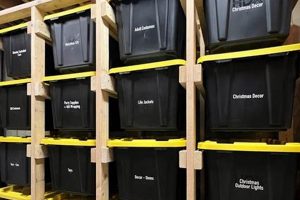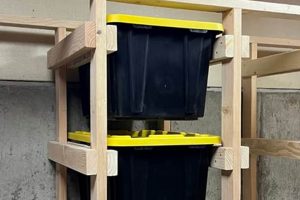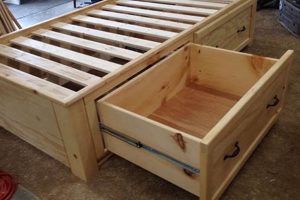Effective utilization of a pickup’s cargo area frequently necessitates customized organizational solutions. These projects, generally involving modifications or additions to the vehicle’s bed, allow owners to tailor the space to meet specific storage needs. An example would be constructing drawers within the truck bed to house tools and equipment, thus maximizing usable space.
Implementing such strategies yields several advantages, including improved cargo security, protection from the elements, and enhanced space efficiency. Historically, simple toolboxes provided basic storage; however, contemporary approaches involve more sophisticated designs incorporating weatherproofing, locking mechanisms, and compartmentalized layouts. This evolution reflects a growing demand for optimized and secure vehicle storage solutions.
The subsequent discussion will examine various construction techniques, materials selection considerations, and design principles applicable to building practical and durable organizational systems for pickup truck cargo areas. This will involve evaluating different approaches for maximizing space, enhancing accessibility, and ensuring the long-term resilience of the chosen storage configuration.
Construction Guidance for Pickup Cargo Area Modifications
The following guidelines offer practical advice for individuals undertaking the construction of customized organizational systems within a pickup truck’s cargo bed. Adherence to these recommendations will contribute to the durability, functionality, and overall effectiveness of the finished project.
Tip 1: Material Selection is Paramount. Prioritize weather-resistant materials such as treated lumber, marine-grade plywood, or aluminum. These materials mitigate the risk of corrosion, warping, and deterioration resulting from exposure to environmental elements. Proper material selection ensures longevity.
Tip 2: Precise Measurement and Planning are Critical. Prior to commencing any construction, meticulously measure the truck bed’s dimensions and create detailed plans. Account for wheel well protrusions, tailgate clearance, and any pre-existing features. Accurate measurements prevent errors and ensure a proper fit.
Tip 3: Secure Fastening Methods are Essential. Employ robust fastening techniques, such as bolting and welding, to create structurally sound connections. Avoid relying solely on adhesives or weak fasteners, which may fail under heavy loads or during vehicular movement. Secure fastening promotes safety and stability.
Tip 4: Weatherproofing Measures are Indispensable. Implement effective weatherproofing strategies, including sealing joints with silicone caulk, applying waterproof coatings, and integrating drainage systems. This prevents water ingress and protects stored contents from damage. Comprehensive weatherproofing extends the lifespan of both the storage system and the stored items.
Tip 5: Prioritize Accessibility and Ergonomics. Design the storage system with accessibility in mind. Consider incorporating sliding drawers, hinged compartments, or removable dividers to facilitate convenient access to stored items. Ensure that the design minimizes physical strain during loading and unloading.
Tip 6: Weight Distribution Considerations are Important. Distribute the weight of the storage system and its contents evenly throughout the truck bed. Avoid concentrating weight in one area, as this can negatively impact vehicle handling and stability. Careful weight distribution enhances safety and preserves vehicle performance.
Tip 7: Implement a Secure Locking Mechanism. Integrate a robust locking mechanism to deter theft and unauthorized access. A secure locking system adds a layer of security to your tools and belongings, promoting safety and minimizing the potential for loss.
These recommendations highlight the importance of careful planning, material selection, and construction techniques when implementing customized organization within a pickup truck’s cargo area. Adherence to these principles will result in a functional, durable, and secure storage solution.
The subsequent section will address the potential limitations and challenges associated with such modifications, as well as strategies for mitigating these risks.
1. Durability
Durability forms the cornerstone of any successful storage construction within a pickup truck’s bed. Given the demanding environment and exposure to diverse elements, a system’s ability to withstand wear, tear, and environmental factors directly impacts its long-term utility and cost-effectiveness. Selection of appropriate materials and construction methods is, therefore, paramount.
- Material Resistance to Environmental Degradation
The truck bed environment exposes storage components to moisture, UV radiation, temperature fluctuations, and potential chemical spills. Material selection must prioritize resistance to these factors. For instance, untreated wood is susceptible to rot and warping, while certain metals may corrode. The use of treated lumber, marine-grade plywood, powder-coated steel, or aluminum is advisable to mitigate these risks, ensuring the storage system maintains its structural integrity over time.
- Structural Integrity Under Load
Pickup truck storage systems are often subjected to significant weight from tools, equipment, and cargo. The chosen construction techniques must ensure the system can bear these loads without deformation or failure. Reinforcements, such as gussets and bracing, can enhance structural integrity, particularly in areas prone to stress concentration. Furthermore, the fastening methods used, such as bolting or welding, must be robust enough to withstand sustained pressure.
- Resistance to Impact and Abrasion
Items stored within a truck bed can shift during transit, leading to impact and abrasion against the storage system’s surfaces. Materials with high impact resistance, such as diamond plate aluminum or heavy-duty plastics, can prevent damage from these forces. Coatings and liners can also provide an additional layer of protection against abrasion, extending the lifespan of the system.
- Joint and Fastener Longevity
The lifespan of a storage system is often limited by the durability of its joints and fasteners. Low-quality fasteners can corrode or loosen over time, compromising the system’s structural integrity. Utilizing corrosion-resistant fasteners, such as stainless steel bolts, and employing robust joining techniques, such as welding or interlocking joinery, can significantly extend the service life of the system.
The facets of material resilience, structural stability, impact resistance, and joint longevity all contribute directly to the overall durability of a truck bed organizational implementation. By carefully considering these factors during the design and construction phases, one can create a storage solution that provides years of reliable service, minimizing the need for frequent repairs or replacements and ultimately maximizing the investment’s return.
2. Security
Security is a paramount concern when considering customized organizational systems within a pickup truck’s cargo area. The open nature of a truck bed inherently presents vulnerabilities to theft and unauthorized access, necessitating the integration of robust security measures within “truck bed diy storage” designs.
- Locking Mechanisms
The integration of effective locking mechanisms is fundamental to securing items stored within the truck bed. This encompasses a range of options, from simple keyed latches to more sophisticated electronic locking systems with remote access capabilities. The selection of an appropriate locking mechanism depends on the value of the stored contents and the desired level of security. Examples include installing a locking tonneau cover over a drawer system or utilizing padlocks on individual compartments within a custom storage unit. The absence of a reliable locking system significantly increases the risk of theft, rendering the investment in other storage features less effective.
- Concealment
Concealing the contents of the truck bed can act as a deterrent to potential thieves. Building storage compartments that are flush with the bed floor or utilizing a solid tonneau cover to obscure the view of stored items can reduce the likelihood of attracting unwanted attention. The principle is that if valuables are not visible, they are less likely to be targeted. For example, constructing a false floor within the truck bed to hide tools or equipment beneath a seemingly empty cargo area can provide a significant level of concealment.
- Alarm Systems and Tracking Devices
For high-value tools or equipment, integrating alarm systems or tracking devices within the “truck bed diy storage” system can provide an additional layer of security. Alarm systems can alert the owner to unauthorized access attempts, while tracking devices can aid in the recovery of stolen items. Examples include installing a GPS tracker within a tool chest or connecting a door sensor to an existing vehicle alarm system. These technologies provide active security measures that can mitigate the consequences of a theft attempt.
- Reinforced Construction
The physical construction of the storage system itself can contribute to security. Utilizing robust materials and reinforcing vulnerable points, such as hinges and latches, can make it more difficult for thieves to break into the storage unit. For example, using heavy-gauge steel for the construction of a tool drawer and reinforcing the drawer slides can deter forced entry. A well-built and reinforced storage system acts as a physical barrier, increasing the time and effort required to gain access, which can deter opportunistic thieves.
The multifaceted approach to security, encompassing locking mechanisms, concealment strategies, alarm systems, and reinforced construction, is essential for safeguarding valuable tools and equipment stored within a pickup truck’s cargo area. By integrating these security features into a “truck bed diy storage” design, owners can significantly reduce the risk of theft and protect their investment.
3. Accessibility
Accessibility is a critical design consideration for any “truck bed diy storage” system. The ease with which items can be retrieved from or placed within the storage area directly impacts the user’s efficiency and overall satisfaction. Poorly designed systems, regardless of their storage capacity or security features, become hindrances if accessing their contents is cumbersome or time-consuming. This necessitates a focus on ergonomic design and intuitive organization within the construction phase.
Several factors contribute to the accessibility of a pickup’s customized storage. Drawer systems, for example, offer a significant advantage by allowing users to slide out tools or equipment without needing to climb into the truck bed. Similarly, hinged compartments or swing-out toolboxes provide easy access to frequently used items. The height and reach required to access different compartments must be carefully considered, particularly for users with limited mobility. Weight distribution also plays a role; evenly distributed weight allows for smoother operation of drawers and doors, further enhancing accessibility. A concrete illustration is the comparison between a cluttered truck bed where tools are randomly piled, necessitating significant time and effort to locate a specific item, and a well-organized drawer system where tools are easily identifiable and accessible with minimal effort.
In summary, accessibility should be a central tenet in the design and implementation of “truck bed diy storage” solutions. Prioritizing ergonomic design, intuitive organization, and careful consideration of user needs will result in a system that not only maximizes storage space but also enhances efficiency and minimizes physical strain. Ignoring accessibility in favor of solely focusing on storage volume or security can ultimately lead to a less effective and less user-friendly storage solution.
4. Space Optimization
The concept of space optimization is intrinsic to the effective utilization of a pickup truck’s cargo area. Given the finite dimensions of the truck bed, maximizing storage capacity and functionality necessitates meticulous planning and innovative design solutions. Therefore, careful consideration of space optimization strategies is essential for any “truck bed diy storage” project seeking to enhance utility.
- Vertical Stacking and Layering
Exploiting vertical space through stacking and layering is a fundamental method for optimizing cargo area volume. This involves constructing tiered storage compartments, drawers, or shelving systems to effectively use the height of the truck bed. For instance, a platform can be built above the wheel wells, creating a secondary storage level for lighter items while preserving the primary floor space for heavier loads. This approach is particularly valuable when accommodating a diverse range of tools and equipment.
- Customized Compartmentalization
Dividing the cargo area into specifically sized compartments tailored to the dimensions of frequently carried items is a key strategy. This prevents wasted space around irregularly shaped objects and allows for more efficient organization. Examples include constructing individual slots for power tools, designated compartments for spare parts, or custom-fitted containers for camping gear. This approach contrasts with using generic containers, which often result in inefficient space utilization.
- Multi-Functional Components
Designing storage elements that serve multiple purposes enhances space efficiency. For example, a platform can serve as both a flat cargo surface and a housing for drawers or sliding toolboxes. Similarly, a toolbox lid can be designed to function as a work surface when open. These multi-functional approaches minimize the number of dedicated components required, thereby freeing up valuable space for other storage needs. This approach echoes principles of efficient design found in compact living spaces.
- Wheel Well Integration
Wheel wells often represent an area of wasted space within a truck bed. Designing storage solutions that specifically integrate with and around the wheel wells can significantly enhance overall storage capacity. Examples include building custom storage boxes that fit snugly over the wheel wells or constructing drawers that slide beneath them. This strategy effectively utilizes otherwise unusable space, maximizing the potential storage volume within the truck bed. Careful measurement and planning are crucial for successful implementation.
The application of these space optimization principlesvertical stacking, customized compartmentalization, multi-functional components, and wheel well integrationdirectly contributes to the success of any “truck bed diy storage” endeavor. By prioritizing these strategies, owners can significantly increase the usable storage capacity of their truck beds, enhancing functionality and organization without compromising available space.
5. Weather Resistance
Exposure to environmental elements constitutes a significant challenge for any storage structure within a pickup truck’s cargo area. Consequently, weather resistance is a critical factor in the design and construction of effective “truck bed diy storage” systems. The primary cause-and-effect relationship is clear: inadequate protection from weather leads to material degradation, compromised structural integrity, and potential damage to stored contents. Consider, for instance, a wooden drawer system lacking proper sealing; repeated exposure to rain and humidity will inevitably result in warping, rot, and the eventual failure of the structure. The importance of weather resistance is further underscored by the fact that tools, equipment, and other stored items can be severely damaged by water, rust, or prolonged exposure to UV radiation. Without adequate weatherproofing, the functional lifespan of the storage system is significantly reduced, negating the investment in materials and labor.
Practical application of weather-resistant design principles involves several considerations. Material selection is paramount; pressure-treated lumber, marine-grade plywood, aluminum, and durable plastics offer inherent resistance to moisture and UV radiation. Proper sealing of joints and seams with silicone caulk or similar materials prevents water ingress. Drainage systems should be incorporated to allow any water that does enter the storage area to escape. Furthermore, exterior surfaces should be coated with weather-resistant paints, sealants, or protective films. A real-world example might involve the construction of a tool chest with overlapping lids and weather stripping to minimize water penetration, combined with a sloped floor to facilitate drainage. In colder climates, thermal insulation can also be considered to prevent condensation and freezing damage.
In conclusion, weather resistance is not merely an ancillary feature of “truck bed diy storage” but a fundamental requirement for ensuring longevity and safeguarding stored contents. The challenges posed by environmental exposure necessitate a proactive approach, incorporating appropriate materials, construction techniques, and protective measures. By prioritizing weather resistance, individuals can create robust and reliable storage solutions that withstand the rigors of outdoor use, maximizing the value and utility of their pickup truck. Neglecting this crucial aspect ultimately leads to premature system failure and potential financial loss.
6. Weight Distribution
Improper weight distribution within a “truck bed diy storage” system can precipitate a cascade of adverse effects, ranging from compromised vehicle handling to accelerated wear on suspension components and tires. This connection stems from the fundamental principles of vehicle dynamics: a pickup truck’s stability and responsiveness are predicated on a balanced load. Concentrating weight excessively at the rear, for instance, elevates the center of gravity, exacerbating body roll during cornering and potentially inducing instability under braking. Conversely, a front-heavy configuration can diminish traction at the rear wheels, particularly on slippery surfaces. These phenomena are not merely theoretical; a concrete illustration is a pickup truck with a densely packed toolbox positioned solely behind the rear axle, leading to noticeable rear-end sag and diminished steering precision. Therefore, weight distribution must be regarded as a critical design parameter, not a mere afterthought.
Effective management of weight distribution within “truck bed diy storage” entails strategic placement of heavier items closer to the truck’s cab and directly over or slightly forward of the rear axle. This approach minimizes leverage effects and maintains a more stable center of gravity. Furthermore, evenly distributing the load across the truck bed, rather than concentrating it on one side, prevents asymmetrical stress on the suspension system. For instance, a custom-built drawer system spanning the width of the truck bed allows for a more balanced distribution compared to a single, bulky toolbox on one side. Periodic inspection of tire wear patterns can provide valuable insight into the effectiveness of the weight distribution strategy. Uneven wear often signals an imbalance, prompting adjustments to the storage configuration.
In summation, the relationship between weight distribution and “truck bed diy storage” is one of direct cause and effect, impacting vehicle safety, handling, and component longevity. A well-conceived storage system prioritizes balanced load distribution, mitigating the risks associated with uneven weight. While challenges may arise in achieving perfect equilibrium, a conscientious approach to weight management is essential for optimizing the performance and extending the service life of both the pickup truck and its customized storage system.
7. Modularity
The principle of modularity offers a significant advantage in the design and implementation of “truck bed diy storage” systems. Its inherent flexibility facilitates adaptation to evolving needs and varying cargo requirements. This approach contrasts with fixed, non-adjustable configurations that may become obsolete as storage needs change.
- Interchangeable Components
Modularity relies on the use of standardized components that can be easily interchanged or reconfigured within the storage system. This allows the user to adapt the storage layout to accommodate different tools, equipment, or cargo loads. Examples include using adjustable dividers within drawers, interchangeable shelf units, or modular toolbox components that can be rearranged to suit specific requirements. This adaptability ensures the storage system remains relevant and useful over time, maximizing the initial investment.
- Scalability and Expansion
A modular “truck bed diy storage” system can be readily scaled up or expanded as the user’s needs grow. This may involve adding additional drawers, shelving units, or toolbox modules to the existing configuration. The ability to incrementally expand the system avoids the need to completely replace the entire storage setup when increased capacity is required. For example, a user might initially construct a basic drawer system and subsequently add a lockable toolbox module as their tool collection expands.
- Customization and Personalization
Modularity enables a high degree of customization, allowing users to tailor the storage system to their specific needs and preferences. This involves selecting from a range of available modules and arranging them in a configuration that optimizes storage space and accessibility. Users can choose from a variety of drawer sizes, shelf depths, and toolbox configurations to create a truly personalized storage solution. This level of customization ensures the system aligns perfectly with the user’s workflow and organizational preferences.
- Simplified Maintenance and Repair
In the event of damage to a component of a modular storage system, the affected module can be easily replaced without requiring the disassembly of the entire system. This significantly simplifies maintenance and repair procedures. For example, if a drawer slide fails, the drawer unit can be removed and the slide replaced without affecting the functionality of the other drawers. This modular approach minimizes downtime and reduces the cost of repairs.
In conclusion, the integration of modularity into “truck bed diy storage” designs fosters adaptability, scalability, and ease of maintenance. By prioritizing modularity, users can create storage solutions that evolve alongside their needs, providing long-term utility and maximizing their investment in customized cargo organization.
Frequently Asked Questions
The following section addresses common inquiries regarding the design, construction, and implementation of customized organizational systems within pickup truck cargo beds. The information provided is intended to offer clarity and guidance for individuals undertaking such projects.
Question 1: What are the primary safety considerations when building organizational components for a truck bed?
Structural integrity is paramount. The chosen materials must withstand the anticipated load. Fastening methods must be robust to prevent component detachment during vehicle operation. Weight distribution should be carefully considered to avoid compromising vehicle handling and stability. Sharp edges or protrusions must be eliminated to minimize the risk of injury. Securing the load and ensuring the materials are fire retardant are important considerations.
Question 2: What type of materials is most suitable for constructing a durable weather-resistant storage system?
Marine-grade plywood, treated lumber, aluminum, and certain durable plastics exhibit superior resistance to environmental degradation. These materials mitigate the risk of corrosion, warping, and rot caused by exposure to moisture, UV radiation, and temperature fluctuations. The selection depends on budget, weight constraints, and desired aesthetic qualities. Steel and fiberglass reinforced polymers are important alternatives.
Question 3: How can theft be prevented in truck bed storage designs?
Implementing robust locking mechanisms is critical. Consider recessed latches, padlock hasps, or electronic locking systems. Reinforce vulnerable points, such as hinges and seams, to deter forced entry. Conceal the contents of the storage system using tonneau covers or integrated compartments. The installation of an alarm system or GPS tracking device may be considered for high-value items.
Question 4: What is the best way to optimize the use of space within a truck bed storage system?
Utilize vertical stacking and layering to maximize storage volume. Construct customized compartments tailored to the dimensions of frequently carried items. Design multi-functional components that serve multiple purposes. Integrate storage solutions around and over the wheel wells. The goal is to make use of the limited space available effectively.
Question 5: How can the weight of the storage system and its contents be properly distributed to maintain vehicle stability?
Position heavier items closer to the truck’s cab and over or slightly forward of the rear axle. Distribute the load evenly across the truck bed to prevent asymmetrical stress on the suspension. Avoid concentrating weight on one side of the vehicle. Regular inspection of tire wear patterns will help find inconsistencies.
Question 6: What measures can be taken to ensure the accessibility of items stored within a truck bed storage system?
Incorporate sliding drawers, hinged compartments, or swing-out toolboxes to facilitate easy access to stored items. Design the storage system with ergonomic considerations in mind, minimizing the need for excessive bending or reaching. Clearly label or organize compartments to quickly locate desired items. The accessibility of items must be thought of as an integral element of the design.
In summary, the successful implementation of a “truck bed diy storage” project requires careful consideration of safety, material selection, security, space optimization, weight distribution, and accessibility. Addressing these factors will result in a functional, durable, and secure storage solution.
The subsequent section will explore the potential limitations and challenges associated with such modifications, as well as strategies for mitigating these risks.
Conclusion
Effective implementation of “truck bed diy storage” solutions demands careful consideration of material selection, structural integrity, security measures, space optimization, weight distribution, and accessibility. These factors directly influence the system’s durability, functionality, and safety, impacting its long-term value and utility. The preceding exploration has highlighted the interconnectedness of these elements, underscoring the need for a holistic design approach.
Prospective builders are encouraged to critically assess their specific requirements and constraints, prioritizing informed decision-making throughout the design and construction process. A well-executed system enhances vehicle utility and protects valuable equipment, but failure to address key design parameters can lead to compromised performance, safety risks, and ultimately, a diminished return on investment.







![Build Your Own! Storage Bin Rack DIY Project [Easy] The DIY Hub: Creative Crafts, Repairs & Life Hacks Build Your Own! Storage Bin Rack DIY Project [Easy] | The DIY Hub: Creative Crafts, Repairs & Life Hacks](https://craftingdiycenter.com/wp-content/uploads/2025/07/th-1825-300x200.jpg)